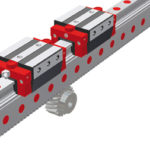Profiled rail guides – especially those that use recirculating balls or rollers – are pervasive in industrial motion applications, with high load capacities, high stiffness, and a wide variety of styles and sizes to choose from. In fact, the sheer number of options for recirculating ball or roller style profiled rails can make selecting the right product an intimidating task. But understanding a few key design concepts and performance criteria can help cut down on the time and effort it takes to select the right product. That’s why we’ve compiled this list of educational and how-to articles for selecting the right profiled rail guide for any application.
Recirculating linear bearings – An explanation of the differences between recirculating and non-recirculating linear bearings and their relative strengths and weaknesses.

Linear guide terminology – An introduction to the various types, technical specifications, and construction principles of recirculating linear guides.
Linear bearing construction – In-depth information on the principles of track geometry and raceway arrangement, and why they matter in some applications.

Linear guide accuracy – An explanation of what “accuracy” means in relation to recirculating linear guides, how it’s specified, and when it matters.
Introduction to preload – A primer explaining what preload is and how it’s achieved in linear guides.
Linear guide preload – A more in-depth look at how preload affects recirculating linear guide assemblies, especially in terms of accuracy and deflection.

When to use two profiled rails – This article explains what types of applications call for two profiled rails mounted in parallel.
Dealing with alignment errors – Profiled rails generally require machined mounting surfaces, but there are some designs that can tolerate imprecise mounting and misalignment.
Linear guide interchanges – If you need to replace an existing linear guide, it’s important to understand which types are (and are not) interchangeable, and what to consider in terms of dimensional and performance differences.

Round shaft vs. profiled rail – A comparison of the two technologies, and when a round shaft may be the better choice.
Feature image credit: Schaeffler Group Inc.







Leave a Reply
You must be logged in to post a comment.